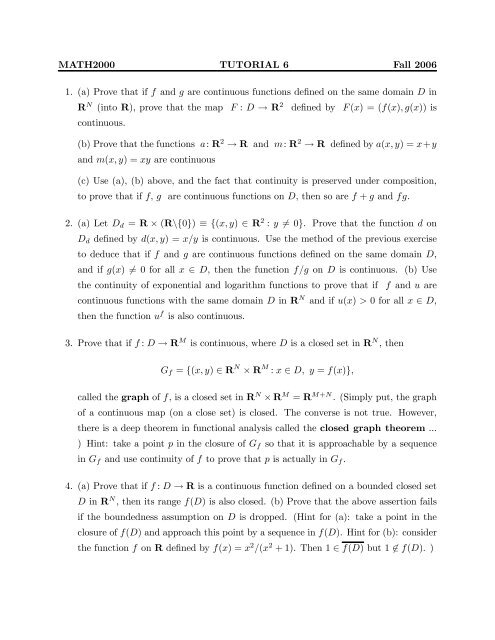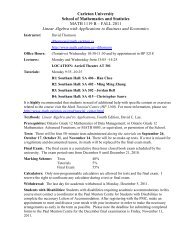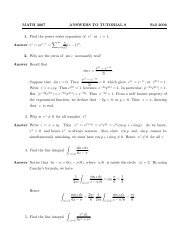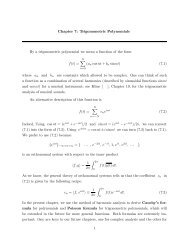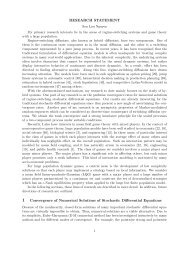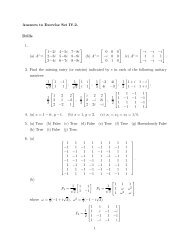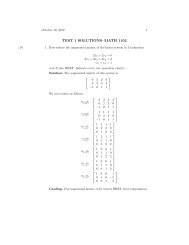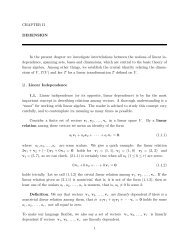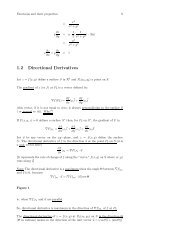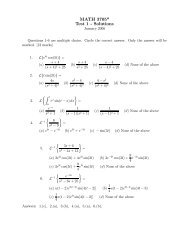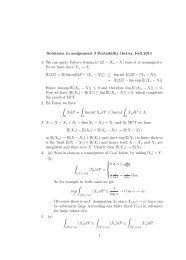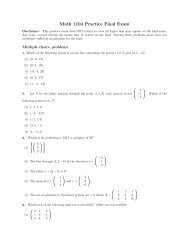MATH2000 TUTORIAL 6 Fall 2006 1. (a) Prove that if f and g are ...
MATH2000 TUTORIAL 6 Fall 2006 1. (a) Prove that if f and g are ...
MATH2000 TUTORIAL 6 Fall 2006 1. (a) Prove that if f and g are ...
Create successful ePaper yourself
Turn your PDF publications into a flip-book with our unique Google optimized e-Paper software.
<strong>MATH2000</strong> <strong>TUTORIAL</strong> 6 <strong>Fall</strong> <strong>2006</strong><br />
<strong>1.</strong> (a) <strong>Prove</strong> <strong>that</strong> <strong>if</strong> f <strong>and</strong> g <strong>are</strong> continuous functions defined on the same domain D in<br />
R N (into R), prove <strong>that</strong> the map F : D → R 2 defined by F (x) = (f(x), g(x)) is<br />
continuous.<br />
(b) <strong>Prove</strong> <strong>that</strong> the functions a: R 2 → R <strong>and</strong> m: R 2 → R defined by a(x, y) = x+y<br />
<strong>and</strong> m(x, y) = xy <strong>are</strong> continuous<br />
(c) Use (a), (b) above, <strong>and</strong> the fact <strong>that</strong> continuity is preserved under composition,<br />
to prove <strong>that</strong> <strong>if</strong> f, g <strong>are</strong> continuous functions on D, then so <strong>are</strong> f + g <strong>and</strong> fg.<br />
2. (a) Let Dd = R × (R\{0}) ≡ {(x, y) ∈ R 2 : y = 0}. <strong>Prove</strong> <strong>that</strong> the function d on<br />
Dd defined by d(x, y) = x/y is continuous. Use the method of the previous exercise<br />
to deduce <strong>that</strong> <strong>if</strong> f <strong>and</strong> g <strong>are</strong> continuous functions defined on the same domain D,<br />
<strong>and</strong> <strong>if</strong> g(x) = 0 for all x ∈ D, then the function f/g on D is continuous. (b) Use<br />
the continuity of exponential <strong>and</strong> logarithm functions to prove <strong>that</strong> <strong>if</strong> f <strong>and</strong> u <strong>are</strong><br />
continuous functions with the same domain D in R N <strong>and</strong> <strong>if</strong> u(x) > 0 for all x ∈ D,<br />
then the function u f is also continuous.<br />
3. <strong>Prove</strong> <strong>that</strong> <strong>if</strong> f : D → R M is continuous, where D is a closed set in R N , then<br />
Gf = {(x, y) ∈ R N × R M : x ∈ D, y = f(x)},<br />
called the graph of f, is a closed set in R N × R M = R M+ N . (Simply put, the graph<br />
of a continuous map (on a close set) is closed. The converse is not true. However,<br />
there is a deep theorem in functional analysis called the closed graph theorem ...<br />
) Hint: take a point p in the closure of Gf so <strong>that</strong> it is approachable by a sequence<br />
in Gf <strong>and</strong> use continuity of f to prove <strong>that</strong> p is actually in Gf.<br />
4. (a) <strong>Prove</strong> <strong>that</strong> <strong>if</strong> f : D → R is a continuous function defined on a bounded closed set<br />
D in R N , then its range f(D) is also closed. (b) <strong>Prove</strong> <strong>that</strong> the above assertion fails<br />
<strong>if</strong> the boundedness assumption on D is dropped. (Hint for (a): take a point in the<br />
closure of f(D) <strong>and</strong> approach this point by a sequence in f(D). Hint for (b): consider<br />
the function f on R defined by f(x) = x 2 /(x 2 + 1). Then 1 ∈ f(D) but 1 ∈ f(D). )
<strong>MATH2000</strong> ANSWERS TO <strong>TUTORIAL</strong> 6 <strong>Fall</strong> <strong>2006</strong><br />
<strong>1.</strong> (a) Take any point x0 ∈ D. Let ε > 0 be given. By the continuity of f <strong>and</strong> g, we<br />
know <strong>that</strong> there exists δ > 0 such <strong>that</strong> |f(x) − f(x0)| < ε/2 <strong>and</strong> |g(x) − g(x0)| < ε/2<br />
for all x ∈ D ∩ Bδ(x0). Consequently, for all x ∈ D ∩ Bδ(x0),<br />
F (x) − F (x0) = (f(x), g(x)) − (f(x0), g(x0)) = (f(x)−f(x0)) 2 +(g(x)−g(x0) 2<br />
≤ |f(x) − f(x0)| + |g(x) − g(x0)| < ε/2 + ε/2 = ε.<br />
Hence F = (f, g) is continuous. (Here we have used an elementary inequality for<br />
given nonnegative numbers a, b: √ a 2 + b 2 ≤ a + b. This can be ver<strong>if</strong>ied as follows:<br />
√ a 2 + b 2 ≤ √ a 2 + 2ab + b 2 = a + b.)<br />
(b) Suppose (x0, y0) ∈ R 2 <strong>and</strong> ε > 0 <strong>are</strong> given. Let δ be a positive number to be<br />
determined. Let (x, y) ∈ R 2 with (x, y) − (x0, y0) ≡ (x − x0) 2 + (x − x0) 2 < δ.<br />
Then we have |x − x0|, |y − y0| < δ <strong>and</strong> hence<br />
|a(x, y) − a(x0, y0)| = |(x + y) − (x0 + y0)| ≤ |x − x0| + |y − y0| < 2δ<br />
So |a(x, y) − a(x0, y0)| < ε when we let δ = ε/2. Also, assuming δ < 1, we have<br />
|m(x, y) − m(x0, y0)| = |xy − x0y0| = |(x − x0)y + x0(y − y0)|<br />
≤ |x − x0|(|y − y0| + |y0|) + |x0||y − y0| < δ(1 + |y0|) + |x0|δ<br />
So we have |m(x, y) − m(x0, y0)| < ε when we let δ = (1 + |x0| + |y0|) −1 ε.<br />
(c) From the fact <strong>that</strong> continuity is preserved under composition, we see <strong>that</strong> the<br />
functions f + g = a ◦ (f, g) <strong>and</strong> fg = m ◦ (f, g) <strong>are</strong> continuous.<br />
2. (a) Take any point (x0, y0) ⊂ R 2 with y0 = 0. Suppose <strong>that</strong> ε > 0 is given. Set<br />
δ > 0 to be determined. Take (x, y) ∈ R 2 with y = 0 such <strong>that</strong> (x, y)−(x0, y0) < δ.<br />
Then |x − x0|, |y − y0| < δ <strong>and</strong> hence<br />
<br />
<br />
|d(x, y) − d(x0, y0)| = <br />
x x0 <br />
− <br />
y y0<br />
= |xy0 − x0y|<br />
|y||y0|<br />
= |(x − x0)y − x0(y − y0)|<br />
|y||y0|<br />
≤ |x − x0|(|y − y0| + |y0|) + |x0||y − y0|<br />
(assuming |y − y0| < |y0|)<br />
(|y0| − |y − y0|)|y0|<br />
≤ 2δ|y0| + |x0|δ<br />
(assuming |y − y0| ≤ |y0|/2)<br />
(|y0|/2)|y0|<br />
= Mδ, where M = 4(|x0| + |y0|)/|y0| 2 .
Notice <strong>that</strong> M ≥ 2|y0|/|y0| 2 = 2/|y0|. Now we set δ = M −1 min{ε, 1}. Then<br />
|y − y0| < δ implies |y − y0| < M −1 ≤ |y0|/2. Thus (x, y) − (x0, y0) < δ implies<br />
|d(x, y) − d(x0, y0)| < ε. The continuity of f/g follows from f/g = d ◦ (f, g) <strong>and</strong> the<br />
argument used in the previous exercise.<br />
(b) For (x, y) ∈ R 2 with y > 0, we have<br />
h(x, y) ≡ y x = (e ln y ) x x(ln y)<br />
= e<br />
giving us h = exp ◦m ◦ (id, ln), where id st<strong>and</strong>s for the identity function, m st<strong>and</strong>s<br />
for the multiplication function defined in the previous exercise. Thus h is a continuous<br />
function. Hence u f = h ◦ (f, u) is continuous.<br />
3. It is enough to check <strong>that</strong> the closure Gf of Gf is contained in Gf. Take a point<br />
p = (x, y) in Gf where x ∈ R N <strong>and</strong> y ∈ R M . Then there is a sequence of<br />
points {pn} in Gf converging to p. For each n, pn = (xn, f(xn)) for some<br />
xn ∈ D. Now limn→ ∞ pn = p becomes limn→ ∞ (xn, f(xn)) = (x, y), which implies<br />
limn→ ∞ xn = x <strong>and</strong> limn→ ∞ f(xn) = y. Since D is closed <strong>and</strong> xn ∈ D for all n,<br />
the limit x of {xn} is also in D. The continuity of f gives limn→ ∞ f(xn) = f(x).<br />
In view of limn→ ∞ f(xn) = y, we get y = f(x). Thus we have x ∈ D <strong>and</strong><br />
p = (x, y) = (x, f(x)), showing <strong>that</strong> p ∈ Df.<br />
4. (a) It suffices to show f(D) ⊆ f(D). Take any point y0 in the closure f(D) of<br />
f(D). Then there is a sequence {yn} in f(D) converges to y0. For each n, there<br />
exists xn ∈ D such <strong>that</strong> yn = f(xn). Since D is bounded <strong>and</strong> closed, in view of the<br />
Bolzano-Weierstrass theorem, the sequence {xn} in D has a convergent subsequence,<br />
say {xnk } with limk→ ∞ xnk = x0 for some x0 ∈ D. By the continuity of f, we have<br />
limk→ ∞ f(xnk ) = f(x0). On the other h<strong>and</strong>, limk→ ∞ f(xnk ) = limk→ ∞ ynk = y0. So<br />
f(x0) = y0, showing <strong>that</strong> y0 ∈ f(D).<br />
(b) Consider the function f on R defined by f(x) = x 2 /(x 2 + 1). Then<br />
lim<br />
n→ ∞<br />
f(n) = lim<br />
n→ ∞<br />
n 2<br />
n 2 + 1<br />
= lim<br />
n→ ∞<br />
1<br />
= 1,<br />
1 + n−2 showing 1 ∈ f(R). But 1 ∈ f(R), because 1 ∈ f(R) would give a 2 /(1 + a 2 ) = 1<br />
for some a ∈ R, or a 2 = a 2 + 1, which is impossible. Hence f(R) is not closed.


